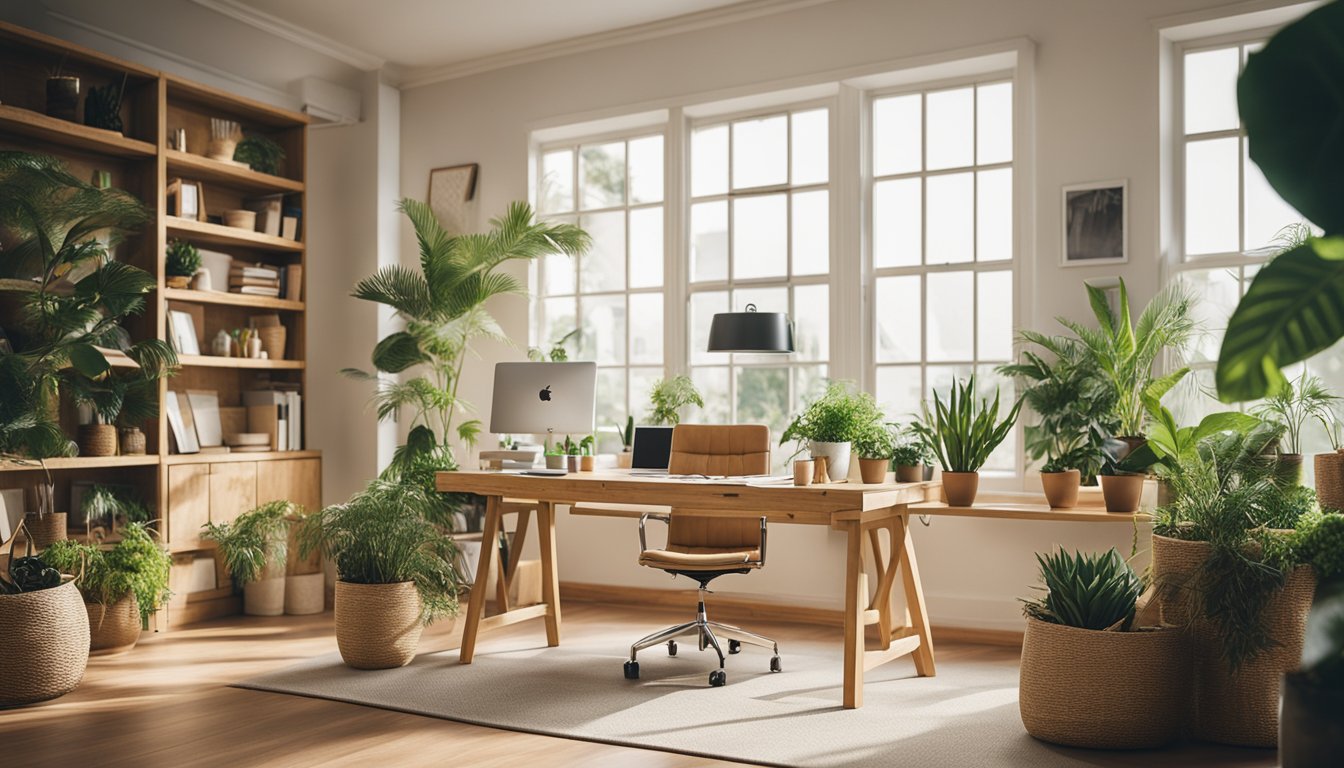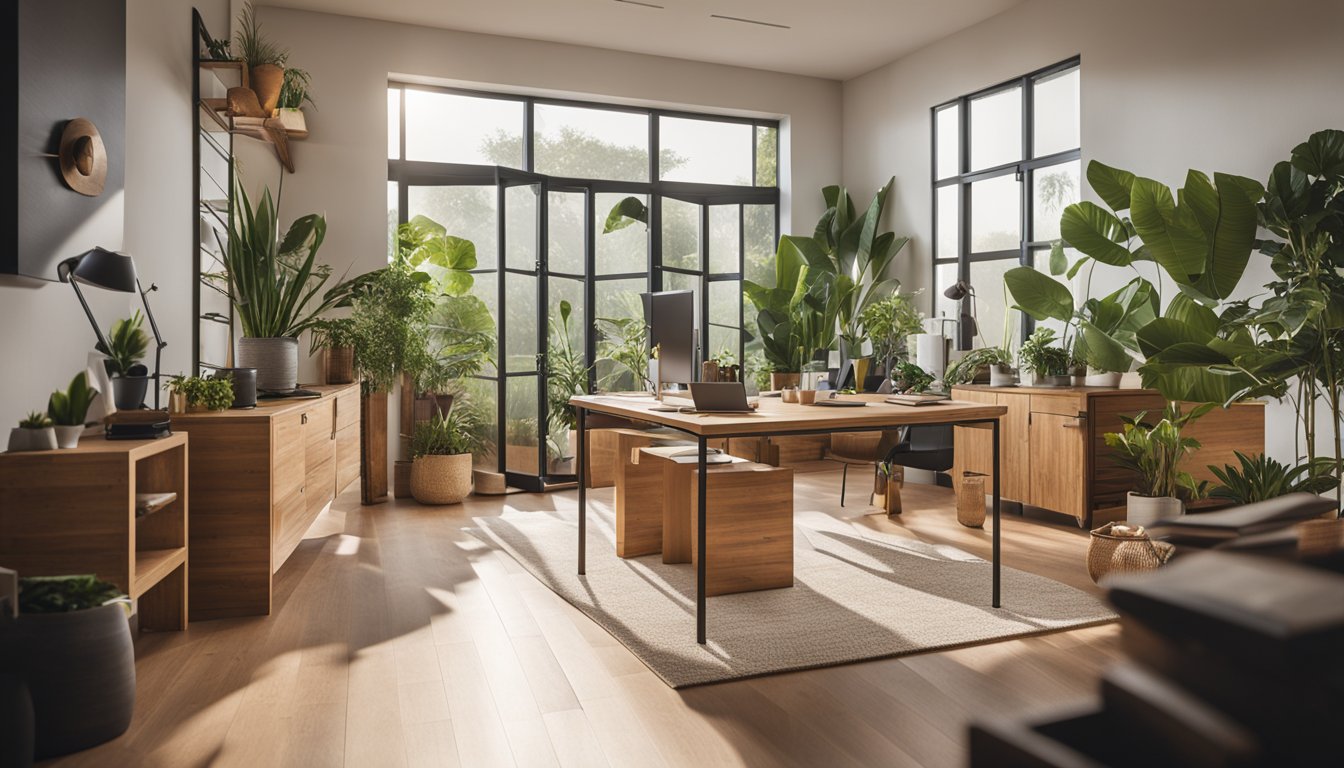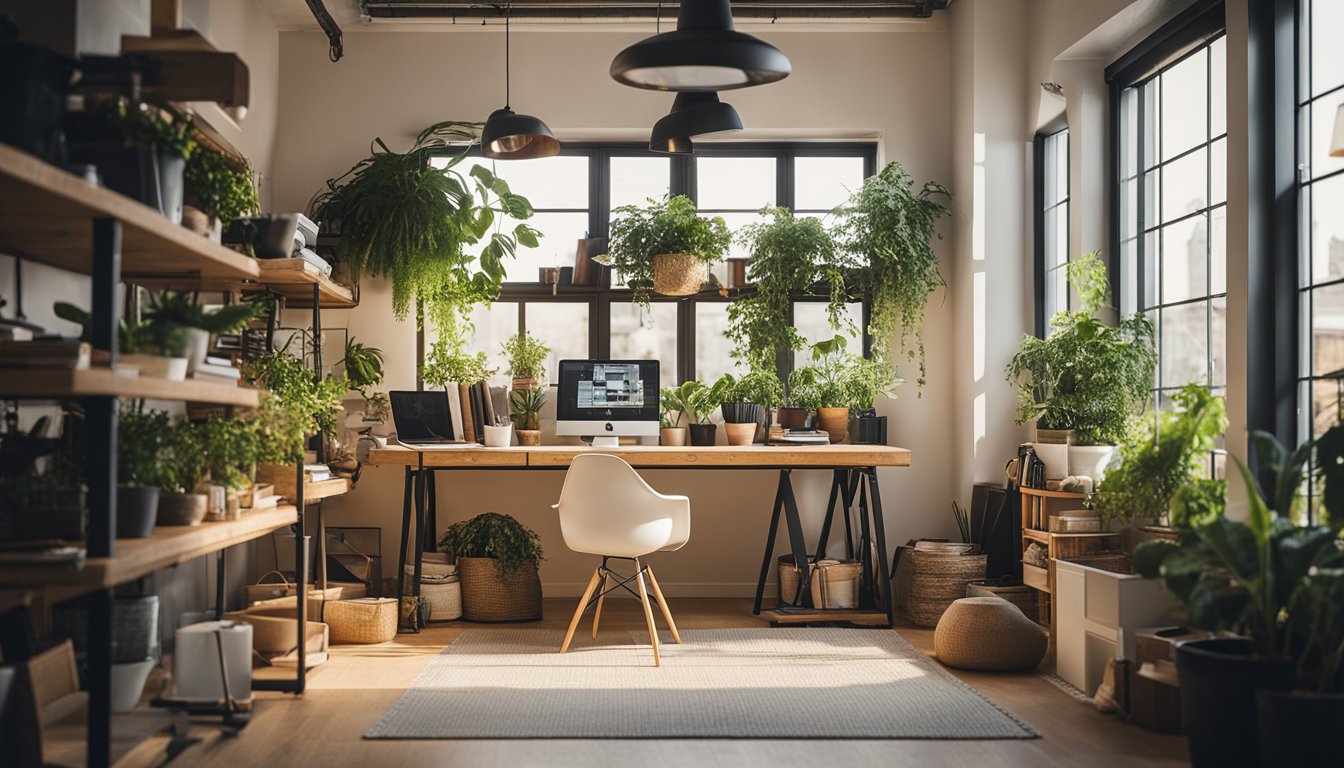Late updated: 02 May 2025 13:05
Written by: Sarah Hollister
Eco-Friendly Home Office Design Tips: Creating a Sustainable Workspace
Creating a home office that is both eco-friendly and inspiring doesn't just reduce our carbon footprint; it also enhances productivity and well-being. Maximising natural light and utilising energy-efficient lighting are simple yet effective steps towards a sustainable workspace. By integrating plants and selecting environmentally-friendly materials, we can transform our home offices into inviting spaces that boost creativity and comfort.

Incorporating innovative design elements can further enrich our remote work experience. Sustainable furniture and smart recycling practices lead not only to a greener office but also to a workspace that reflects our values. Ultimately, a well-designed, eco-friendly home office creates a sense of harmony with the environment, inspiring us daily.
Key Takeaways
- Embrace natural light and energy-efficient lighting
- Choose sustainable furniture and incorporate plants
- Implement smart recycling practices for a green office
Designing a Sustainable Home Office Space
Designing a sustainable home office space involves considering materials, lighting, and ergonomics to minimise our environmental impact. The aim is to reduce our carbon footprint while creating a functional and aesthetically pleasing workspace.
Choosing Sustainable Materials
When selecting materials for a home office, sustainability should be a priority. We should opt for recyclable materials and those sourced from renewable resources. For example, desks made from bamboo or reclaimed wood are both stylish and sustainable.
In addition to choosing eco-friendly materials, it's important to consider the environmental impact during production. Look for certifications such as FSC (Forest Stewardship Council) to ensure products adhere to sustainable practices. Incorporating such materials into our home office aligns with our sustainability goals.
Maximising Natural Light
Natural lighting is vital for reducing our reliance on artificial energy sources. Positioning a desk near a window allows us to harness daylight, creating a bright and inviting space. Natural light not only benefits energy efficiency but also enhances well-being and productivity.
To maximise natural light, we should use light-coloured walls and reflective surfaces that help distribute sunlight. This reduces the need for artificial lighting during the day, lowering our energy consumption and promoting an eco-friendly office environment.
Selecting Energy-Efficient Lighting
When natural lighting is insufficient, selecting energy-efficient options is crucial. LED bulbs are a smart choice, as they consume significantly less energy than traditional bulbs. They also last longer, which means less frequent replacement, contributing to a reduced carbon footprint.
Additionally, investing in efficient lighting systems with dimmers or motion sensors can further reduce energy use. These systems adjust the lighting according to natural light levels or presence, ensuring we use energy only when necessary. This step enhances our commitment to eco-friendly practices.
Eco-Friendly Furniture and Ergonomics
Furnishing our home office with eco-friendly furniture extends beyond materials. Ergonomic design contributes to both comfort and sustainability. When selecting chairs and desks, we should choose options that support proper posture and reduce health risks.
Sourcing furniture from companies committed to sustainable manufacturing practices is also important. Prioritising ergonomic furniture that meets industry standards ensures our workspace not only reduces environmental impact but also promotes health and productivity. By taking these steps, we actively contribute to a more sustainable future.
Smart Practices for an Eco-Friendly Work-from-Home Experience

Our work-from-home experience can be enriched by adopting eco-friendly practices. From utilising technology effectively to optimising air quality, there are various ways we can reduce our environmental footprint. Implementing sustainable storage solutions and creating a productive workspace further enhances both our comfort and efficiency.
Reducing Environmental Footprint with Technology
Integrating technology can significantly advance our sustainable office goals. Energy-efficient appliances like LED monitors not only save energy but also reduce electricity bills. Additionally, using a centralised power strip helps in managing multiple devices simultaneously and minimises phantom power usage.
A high-speed internet connection allows us to conduct virtual meetings smoothly, reducing our reliance on paper. Also, appropriate cable management reduces clutter, encouraging us to focus on tasks without distractions. Energy-efficient devices and smart thermostats can also be paired to further reduce energy consumption.
Improving Air Quality and Wellbeing
Indoor plants are key to enhancing air quality while adding a touch of nature to our workspace. Species like spider plants and peace lilies are known to filter indoor air effectively. We should also consider using eco-friendly paint, which limits the release of harmful chemicals.
Maximising natural light not only benefits our mental health but also supports productivity and creativity, contributing to a healthier work environment. Implementing regular ventilation through open windows also helps maintain fresh air levels, fostering our wellbeing.
Sustainable Organisation and Storage Solutions
Organisation in a sustainable office can greatly impact our overall efficiency. Embracing a recycling program is essential for responsible waste management. We can use sustainable materials like bamboo or recycled wood for storage solutions, which add functionality without compromising our green office values.
Space planning, such as using folding or collapsible furniture, maximises available space and reduces clutter. By prioritising sustainable materials, we uphold our commitment to reducing our environmental impact while maintaining an organised and functional workspace.
Creating a Quiet and Productive Workspace
Soundproofing is effective in crafting a quieter environment, vital for focus and productivity, especially in bustling surroundings. Noise-cancelling technology or soft furnishings such as thick carpets and curtains can reduce ambient noise.
A productive workspace should be free from distractions, allowing us to concentrate fully. Ergonomic furniture arrangements that support good posture also contribute to our comfort and effectiveness, bridging the gap between environmental challenge solutions and personal productivity.
Frequently Asked Questions

In our quest for creating an eco-friendly home office, we explore the best sustainable materials for furniture, ways to boost energy efficiency, and how to minimise paper waste. We delve into eco-friendly gadgets and appliances, the benefits of natural lighting, and the perfect plants for a greener environment.
What are the best sustainable materials to use for home office furniture?
Selecting materials like reclaimed wood, bamboo, and recycled metal can contribute to an environmentally friendly office. These materials are often sourced sustainably and provide both durability and style.
How can I improve energy efficiency in my home office?
Utilising LED lighting and energy-efficient laptops are prudent choices. Smart power strips can help reduce idle energy consumption. Positioning your workspace to maximise natural light can also decrease reliance on artificial lighting.
What are some effective ways to reduce paper waste in my home office?
The key is adopting a digital-first approach. Consider using cloud storage and digital note-taking applications. For essential prints, use recycled paper and print on both sides to conserve resources.
Can you suggest any eco-friendly office gadgets and appliances?
Look for Energy Star-rated appliances, which use less energy. Solar-powered chargers or a hand-cranked flashlight serve as sustainable choices that lessen dependence on traditional electricity sources.
How does incorporating natural lighting contribute to a greener home office?
Natural lighting reduces the need for artificial light, minimising electricity usage and reducing your carbon footprint. It also creates a more pleasant and productive atmosphere that can boost well-being.
What plants are recommended for creating a cleaner and greener office environment?
Plants like peace lilies, snake plants, and spider plants are excellent at purifying the air. They not only enhance the aesthetics but also improve air quality, contributing to a healthier workspace.
